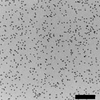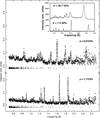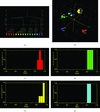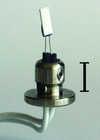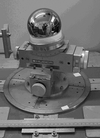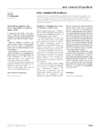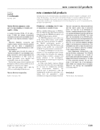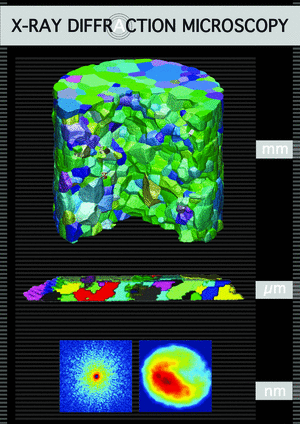issue contents
December 2004 issue

Cover illustration: Volumetric visualization of electron density surrounding a histidine residue, allowing for direct observation of discrete disorder; generated with POVScript+ and rendered with POVRay. Courtesy of T. D. Fenn, D. Ringe & G. A. Petsko [J. Appl. Cryst. (2003), 36, 944-947].
research papers
Small-angle neutron and X-ray scattering of dispersions of oleic-acid-coated magnetic iron particles
The composition of magnetic iron-based core–shell colloids (both non-oxidized and oxidized) is revealed by combining polarized small-angle neutron scattering with contrast variation and small-angle X-ray scattering.
Using neutron powder time-of-flight diffraction over the pressure range 1.27–8.01 GPa as well as X-ray diffraction up to 41 GPa, with Fluorinert as the pressure-transmitting medium, the cubic  phase of ReO3 was found to be stable over 0.5–13.2 GPa and to be highly compressible with a zero-pressure bulk modulus of Bo = 43 (1) GPa. The neutron data were used in least-squares refinements, showing that the ReO6 octahedra remain almost undistorted while the Re—O—Re bond angle decreases from 166.5 (1) to 146.4 (3)° within the investigated pressure range of 1.27 to 8.01 GPa.
phase of ReO3 was found to be stable over 0.5–13.2 GPa and to be highly compressible with a zero-pressure bulk modulus of Bo = 43 (1) GPa. The neutron data were used in least-squares refinements, showing that the ReO6 octahedra remain almost undistorted while the Re—O—Re bond angle decreases from 166.5 (1) to 146.4 (3)° within the investigated pressure range of 1.27 to 8.01 GPa.
The crystallization of a set of well known proteins in pore strips has been tested. The results show that crystallization in pore strips is possible, and that nucleation is comparable with that in hanging drops despite the use of smaller volumes.
Details of the sample management system at the RIKEN Structural Genomics Beamlines equipped with the sample mounting robot SPACE (SPring-8 Precise Automatic Cryo-sample Exchanger) are described.
Open  access
access
 access
accessSilhouettes and fuzzy clustering are used to validate cluster assignments when clustering powder diffraction patterns derived from high-throughput experiments.
Open  access
access
 access
accessEnergy-dispersive synchrotron X-ray diffraction has been employed to map the residual strains around cracks in bulk samples with high spatial and strain resolution using a multiple-peak Pawley refinement with an asymmetric peak profile.
The effect of the devitrification process on the Zr-containing phases in a CaO–ZrO2–SiO2 glass ceramic has been studied, combining X-ray anomalous diffraction and X-ray absorption spectroscopy techniques.
The resolution in reciprocal space of a triple-axis diffractometer for high-energy X-ray diffraction located at a stationary tungsten tube is described.
Open  access
access
 access
accessThe line-broadening analysis of a ceria size–strain round-robin sample is presented. Measurements that were carried out with seven instruments, including synchrotron and neutron sources, were the basis for the round robin on the size–strain line-broadening analysis methods; the results are presented and discussed.
Ultra-high-energy X-rays of about 35 keV were used for multi-wavelength anomalous diffraction experiments with iodine and xenon derivatives of macromolecular crystals.
Complementary methods have been used to analyse residual stresses in a heat-treated Zr702 sheet which had undergone uniaxial plastic deformation: X-ray diffraction and self-consistent models.
Focusing by bent crystals in Laue geometry is improved by combining geometrical focusing with Borrmann-triangle focusing, based on dynamical theory.
A new step-scan diffraction technique has been developed, which collects angle-dispersive data using a solid-state detector and white synchrotron radiation for multiple-wavelength monochromatic powder diffraction. Data collected both on α-Al2O3 powder at ambient conditions and on a mixture of MgO and Au under high pressure were analyzed using the Rietveld technique with various schemes of data treatment; results demonstrate the feasibility and numerous advantages of this technique in situations where X-ray access is limited.
A probabilistic algorithm for determining the space group from powder diffraction data is presented.
Energy dispersive diffraction was used nondestructively to construct depth profiles of the phases in cement cylinders of ∼12 mm diameter that had been exposed to aqueous sulfate. ∼200 µm spatial resolution along the cylinder radii was achieved at depths of up to ∼4 mm below the specimen surface.
A general description is developed to explain the occurrence and visibility of pseudo-nodes along crystal truncation rods of layered crystals, called `termination interference', and the relationship of this phenomenon to the terminating plane of the crystal. The characteristics of this interference phenomenon are illustrated through model calculations and by comparison with experimental data.
Download citation


Download citation


Open  access
access
 access
accessFocusing optics have been designed and installed for a molybdenum rotating anode and the resulting increase in beam intensity, and hence data quality, has been quantitatively investigated.
Download citation


Download citation


The crystal structure of a new copper(II) complex containing the 1,3-thiazine heterocycle has been determined via molecular modelling coupled with X-ray powder diffractometry.
cryocrystallography papers
Open  access
access
 access
accessThe long-term temperature characteristics of a dry Dewar with three types of crystal storage holder are determined, as well as the short-term effects of removing and replacing the holders from the Dewar.
short communications
Open  access
access
 access
accessA goniometer has been constructed to enable the crystallographic orientation of highly polished single-crystal silicon spheres, with a mass of 1 kg, to be determined using the back-reflection Laue technique.
The specific interfacial area of a crystalline–amorphous two-phase system was investigated using small-angle X-ray scattering.
Crystalline structures of Cr–N films have been studied using electron diffraction. A CrN cubic structure with vacancies instead of a Cr2N hexagonal structure was observed in thin films of thickness ∼50 nm prepared under a low N2 partial pressure ( = 3 × 10−3 Pa).
= 3 × 10−3 Pa).
The empirical monoparametric function SR = (θ/90)(S/θ) (where S is the refinable parameter and the angle θ is given in degrees) has been suggested for Rietveld analysis as a practical replacement for the commonly used surface roughness correction functions.
computer programs
A computer program for the calculation of symmetry-adapted functions which can be used for the description of various types of ordered structures resulting from symmetry-lowering phase transitions in crystals is presented.
Processing raw small-angle neutron and X-ray scattering data, displaying the scattering curves, and interpreting the curves using interactive plots, is made easy with the Windows-based program PRINSAS.
The new features of EXPO2004, the advanced version of EXPO, are described.
STEREOPOLE is a software package for the analysis of X-ray diffraction pole figures, allowing experimental data to be compared graphically with simulated results, and epitaxic relationships to be evaluated between up to five different crystal layers.
laboratory notes
A new hermetic sample holder for radioactive samples has been developed. Its design offers very accurate and reliable sample positioning.
computer program abstracts
MolXtl is an interactive Microsoft Windows program that allows users to create molecular structures on the computer screen from scratch, modify existing structures, and view, print and store structural images as line drawings or rendered `pixel' drawings. It provides the means to determine fractional coordinates of added atoms, add or subtract atoms or bonds, rotate and translate groups, check for interatomic contacts, select working coordinates, etc.
new commercial products
Free 



 journal menu
journal menu








